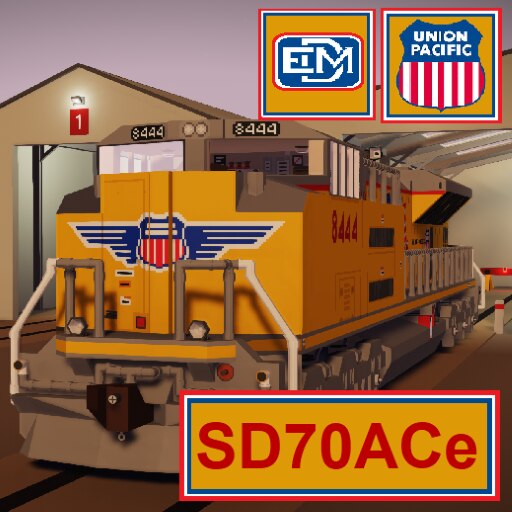[ESS 1.5] Union Pacific EMD SD70ACe
Union Pacific Collection: https://steamcommunity.com/sharedfiles/filedetails/?id=2748808481
EMD had all but lost their title as the biggest seller of diesel locomotives. The SD70M and SD70MAC respectively were not failures like the SD50 and SD60, but had nowhere near the popularity the SD40 had. The GE Dash 9/AC44 series had vastly outsold the SD70 series. In 2004 EPA tier 2 Emissions took effect. General Electric released their new ES44AC to fit these emissions standards, while EMD had took some design notes from GE to better compete with GE and gain back some ground. While the ES44 sported a brand new GEVO-12 prime mover, the EMD 710 would be able to hold out until Tier 4 emissions came along. EMD had widened their cab, made rubber gasket isolated cabs standard, and adopted the "Notch Nose" design to make it easier to enter the cab from the nose. EMD had made considerable improvements, but the 2 stroke 710 was still loud and uncomfortable for engineers. Engineers often complained the displays were not user friendly and the locomotive was overall less spacious and comfortable than the GE menace. That along with being released later than the ES44AC hurt EMD’s sales. That being said, the ACe had sold well and EMD was still holding their own. Considering GM had hit a rough patch financially, living government contract to government contract, they had to sell off some branches to make due. EMD was one of those. It was sold to Greenbriar Equity Group L.P. in 2005. Greenbriar continued producing the ACe until they sold EMD to Caterpillar Inc. in 2010, where caterpillar continued production until tier 4 emissions were passed in 2015. Overall the SD70ACe is a reliable locomotive, much more reliable than the GE competitor, but much less comfortable. It’s unique design makes it a favorite among some railfans and has cemented an iconic look for EMD going into the future.
Open the fuse cabinet, Located on the back wall of the cab and flip all breakers on. Then leave the cab and open the door on the lower deck on the ride side of the locomotive, and flip the breaker on the right side. Head back to the cab, hit the "Engine Run" "Generator Field" and "Fuel Pump" switches on the control stand, then hold the "Auto Start" button on the rear wall of the cab until the indicator above is lit, switch the dynamics to on. Isolate the engine, hit the reverser buttons in whatever direction you desire, "1" being backward "2" being neutral and "3" being forward, and your ready for operation.
Very important to read this, as a lot has changed. Basics have stayed the same. Engine run switch on means the locomotive is a master. if its off its a slave. Now the motor polarity is controlled by the headlight controller. Use the arrow buttons to cycle through modes. THIS MUST BE DONE FOR ALL LOCOMOTIVES THAT ARE IN THE TRAIN! Long hood forward means the locomotive is not inverted, while short hood forward reverses the polarity. Use front/intermediate for master locomotives and/or Distributed Power Units. Use Middle for locomotives that are between two or more other locomotives in the front end power. [the main cluster of locomotives at the front of the train is the head end power] Use tail for locomotives at the end of the front end power. When master is on, the controls will reset to front unit. For Distributed Power Units or if you just don’t like using connectors, enable the "receive from radio signal". Make sure all locomotives are set to the same frequency. Distributed Power Units should be set to front/intermediate unit. A properly hooked up train will allow the master to control the frontmost headlights and rearmost headlights of the front end power.


